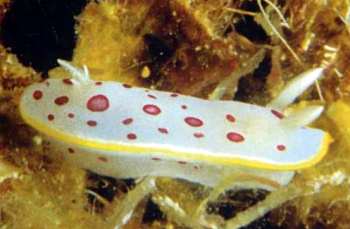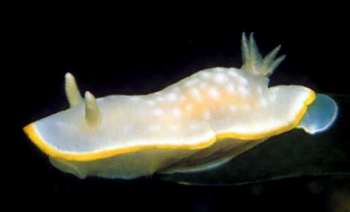Re: Chromodoris elegantula
June 3, 2005
From: Juan Lucas Cervera


Dear Bill,
Concerning your answer [message #13925]:
My comments were based on Perrone's paper (1993). I had no chance to see Philippi's original description of C. elegantula. Sordi's material (1970) [large-spotted form] attributed to C. elegantula match externally the specimens from Sardinia examined by Garcia-Gomez, Cattaneo and Chemello. Even if the Sordi's radula description is poor, it can be considered "similar" in both material.
I attach scans of two photos published in Trainito (2003):
Upper: [Photo 61 identified in Trainito as C. elegantula] This is similar to those [large-spotted form] studied by Garcia-Gomez et al. [see my earlier message #13925 ]
Lower: [Photo 59 identified in Trainito as Chromodoris sp.] I also attach a photo of the supposed undescribed Chromodoris, I mentioned in my earlier message, quite similar to the small-spotted animal that you attibuted to C. elegantula. It lacks any red spotsand Trainito's photo is from Sicily. The radular teeth of the material examined by Garcia-Gomez et al. were amazing since they were... smooth!!!!!!
For this reason, the material examined by Garcia Gomez et al were considered belonging to 2 different species. But what kind of radular teeth have the animals with the small red spots? This would be very useful. This would permit to know if there are three species or two. In the case of two species, we should accept the existence of a degree of variability with the red punctuation or dots.
I cannot tell you more. I have no material and I'm just 'thinking out loud'.
-
Trainito, E. 2003. Arlecchini mediterranei. Guida ai molluschi opistobranchi del Mediterraneo. [Mediterranean harlequins. A Field Guide to Mediterranean Sea Slugs ] Taphros, Olbia, Italy. 58 pp.
Regards.
Lucas.
lucas.cervera@uca.es
Cervera, J.L., 2005 (Jun 3) Re: Chromodoris elegantula. [Message in] Sea Slug Forum. Australian Museum, Sydney. Available from http://www.seaslugforum.net/find/13934Dear Lucas,
Thanks for your participation. I'm glad someone else is willing to join me 'thinking out loud'. The animal with white spots but no red spots is an interesting addition to the puzzle. As you say, there is not much more we can say about these three 'forms' until we get some more anatomical information. There are either one, two or three species. Whatever transpires, it seems clear to me that the form with small red spots is Doris elegantula Philippi, 1844.
As you will see in a separate message [#13946 ] I have permission from Egidio Trainito to publish your scans of the two photos from his book. He also has some interesting comments on the from without red spots.
Best wishes,
Bill Rudman
Related messages
-
Re: Chromodoris elegantula
From: Haluk Akbatur, June 3, 2005 -
Re: Chromodoris elegantula
From: Egidio Trainito, June 3, 2005 -
Re: Chromodoris elegantula
From: Juan Lucas Cervera, June 1, 2005 -
Re: Chromodoris elegantula
From: Haluk Akbatur, May 31, 2005 -
Chromodoris elegantula from Turkey
From: Haluk Akbatur, May 30, 2005 -
Photos of Chromodoris elegantula polychroma
From: Alberto Piras, May 30, 2005
